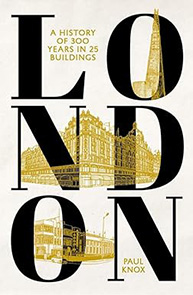Review: London: A History of 300 Years in 25 Buildings by Paul Knox. A guest post by London Historians Member Jane Parker.
 We often read the soundbites on a book jacket and, after buying it, we realise that we have again been duped by clever marketing. Well, not so here. Iain Sinclair’s ‘Incisive and compelling… delivered through brisk histories of era-defining buildings’ rings true, and Mararette Lincoln [a London Historians member – Ed] sums it up perfectly when she writes that Paul Knox’s book ‘shows us that the familiar was once novel and the seemingly ordinary was often momentous’.
We often read the soundbites on a book jacket and, after buying it, we realise that we have again been duped by clever marketing. Well, not so here. Iain Sinclair’s ‘Incisive and compelling… delivered through brisk histories of era-defining buildings’ rings true, and Mararette Lincoln [a London Historians member – Ed] sums it up perfectly when she writes that Paul Knox’s book ‘shows us that the familiar was once novel and the seemingly ordinary was often momentous’.
As fashions change and ideas evolve, so does architecture. London is an enormous 3D showcase of styles throughout the centuries. We are lucky to have such a diversity; many buildings having passed through their teenage years and early twenties when they were not young enough to be celebrated yet not old enough to be of historical value, into respectful adulthood.
Paul Knox has pulled together a cross-section of interesting buildings to cleverly illustrate how architects move with the times. With the aid of maps, photographs, drawings and contemporary advertisements, he takes us on a journey from the glorious Georgian time capsule that is Spencer House in St James’s to the modern mega structures behind Kings Cross station via social housing developments, Victorian shopping emporiums and Art Deco era factories in Battersea, Knightsbridge and Perivale, respectively.
Paul tells us the history behind the stones, bricks and glass. It’s a book to dip into and savour chapter by chapter, site by site. His friendly and informative prose is provocative and well-researched, packed full of interesting snippets and information about the wider subject at hand. Many of the buildings he has chosen as examples of a certain style or purpose are a delightful surprise, such as Abbey Road Studios, a Bethnal Green school and churches in Brick Lane and Turnham Green. Read also about overly-embellished government offices, managed mansion blocks, streamlined factories and both brutalist and brick-built terraces. Well-known and well-visited places are also featured including County Hall, The National Theatre and St Pancras Midland Grand Hotel.
Perhaps Paul might like to write a follow-up companion book about which of London’s most recent or planned constructions will stand the test of time to remain as fine examples for the future? I would certainly buy that book.
_____________________________________
London: A History of 300 Years in 25 Buildings by Paul Knox (448pp) is published by Yale University Press on 23 April. The cover price is £25 but available for less if you shop around.
_____________________________________
Jane Parker is a London Historians Member who specialises in London’s historic streetscape and architectural heritage. She is also a qualified London Guide who can be contacted via her website, Jane’s London Walks.